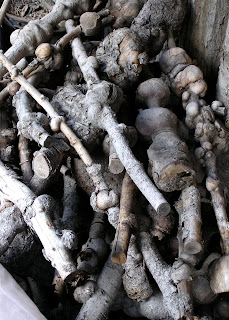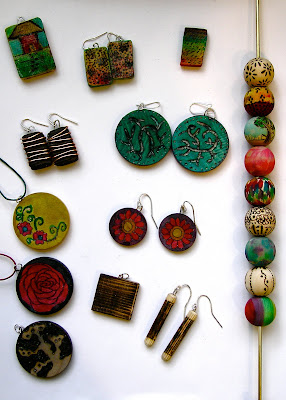
Pilchuck Glass School
Session 3, 2010
Like any savvy institution with a limited marketing budget, Pilchuck Glass School wants to know how you first heard of its existence: was it from a professor? A magazine article? A magazine ad? One of the school's own mailings? I think every printed interaction I've with Pilchuck has included these questions, and while I'd love help out, I'm useless. I honestly can't remember a time when I didn't know about Pilchuck--or a time when I didn't want to go.
Since Pilchuck was founded slightly before I was, in 1972, it's possible that I heard the word very early on. Glass artist Dale Chihuly worked with art supporters Anne Gould Hauberg and John Hauberg to establish a dedicated glass school in the midst of a vast tree farm overlooking Puget Sound (below). Chihuly and his co-horts were dedicated to the notion of working in teams, a European model not then the norm in American glass schools and studios. This approach drastically expanded the scale and scope of the work they were able to achieve, and engendered strong relationships amongst Pilchuck glassworkers and visiting artists.



My course, "Glass with Passion", was lead by Dublin-based glass artist, Róisín de Buitléar. It was geared for novices and those with limited experience, but whereas most introductory glass classes would have beginners repeating the same simple forms, Róisín wanted us to jump right in to making objects that we could engage with. She asked each of us to come to Pilchuck with three items representing three personal passions; these would be the starting point for our glass work.

Above: My class bonding during a "hayride", enjoying Pilchuck's scenic grounds from the back of a mattress-lined truck.
We began with hot casting. By impressing or carving shapes into a mixture of clay and sand, you create a form that you can then fill with molten glass ladled out of the furnace. It's also possible to add extra elements such as leaves, wire, aluminum foil, or crushed glass frit, either to the void or to the surface of the hot glass. At the point when the glass is firm but still hot, you dig it out of the sand and hustle it over to a heated annealing oven, where it will be allowed to cool down slowly so that internal stresses don't cause the glass to crack.


Left: Our amazing teaching assistants making hot casting look easy. Cathy Chase pours and Jono Lukas cuts the stream with shears when the mold is full.
Right: Róisín's cast bundt cakes, still piping hot.
Next, we learned to create casting molds using pieces of steel fitted together like a puzzle. As with sand-casting, the hot glass is poured into the void; then the steel has to be agitated until it sets up so that they don't fuse together permanently.


Left: One of Sam's steel-cast pieces, just after the steel forms have been removed.
Right: My sand casting of a kashigata, after extensive grinding and polishing.
From casting, we moved on to blowing. While I initially assumed that we were progressing through the techniques in order of difficulty, it soon became apparent that another factor was in play. Casting is a team effort, at least for beginners. You need helpers to open the furnace door, to clean your dribbling ladle, to fix your hat (no joke!), and so on, but because the steps are much the same each time, the help is more or less automated, and if one helper does wander off you can yell for another or muddle through.
Blowing, on the other hand, is a much more nuanced dance. Each piece is different and progresses differently; while the person "in charge" can and does give commands, it's ideal if the assistant can anticipate them--at least to the degree of being on the right side of the bench for whatever is coming next. By the time we started blowing, my classmates and I knew each other well enough to develop this kind of communication.


Left: Jono advises as Annie attaches a punty to Erica's piece.
Right: Tamsin shapes her piece with wet newspaper as Tatiana gives it a little air.
The whole undertaking was very difficult for me. Strength, coordination, timing, unflappability, a high pain threshold, pithy communication--none of these qualities are nurtured by my everyday life or required by the kind of work I normally do.
So I decided to try for "simple", making bell jars to place over the small figures I've been carving lately. As I gained experience, they got larger, and thinner, and more regular. Then I gained just enough experience to get cocky and make a big mistake. I blew out a jar that was my largest and thinnest by far; putting it back into the glory hole to heat it for a final round of shaping, I let it get too hot and as I watched it collapsed in on itself. As I pulled it out, my teammates shook their heads: better to break it off and start again. But I reminded myself that I was there to learn, not to be perfect, so I blew it back out, shaped it it the best I could, and put it in the annealer.

That jar (above, far left) turned out to be one of my favorite pieces. It's a nice shape overall, but one wall is punctuated by an irregular scar, formed when the jar collapsed and the wall folded in on itself. It represents an all-too-rare moment when I allowed myself to act on the thought, "I wonder what would happen if...?"
I also started on a series of wood and glass doll forms, based on antique dolls that I saw in a museum several years ago. After one of our first days of glassblowing, I snuck off to the woodshop and turned a wooden doll--ostensibly so that I would have a model to work from, but really so I could feel in control for a little while. I made a few similar forms in solid glass, then got ambitious and did some hollow ones.

Many of my pieces still need to be "coldworked"--to have their sharp edges and rough surfaces ground down on wheels and sanders kept clean and cool by running water. In the meantime, I'm working out how to arrange them, and what to put inside them. Right now, they really are dolls, things that can occupy my hands while my mind plays.
Thank you to Pilchuck, to the staff and instructors, and to my comrades-in-arms! This experience will stick with me for a long time.

Glass is mighty hungry work! Check out my Sweet Travel blog to read about Pilchuck treats such as salmonberries, red huckleberries, and desserts by Holly.



















